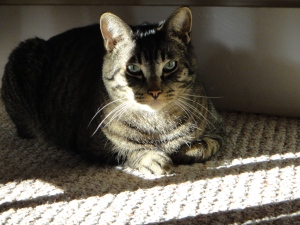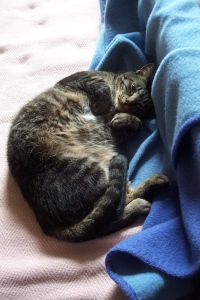April 12, 1916 – March 25, 2021
March 26, 2021
Goodnight, Beverly.
What I Don’t Write Here, And Why
December 21, 2012
When I was 14 or 15 I started keeping a reading log. Then, for kicks, I decided to write down every novel I’d read before I started keeping a reading log, in roughly chronological order. My memory was good back then. In theory I have a record of every novel I’ve ever read from Anne of Green Gables in third grade onward. Is this unusual? My teenaged entries would take up a couple of pages of a blank book. Later came long stretches when I only wrote only titles, authors, publication dates, and dates read, with the intention of going back later to say what I’d thought. Sometimes that happened, sometimes it didn’t. Other times, particularly when I was reading a lot of YA novels, I would write just one summarizing sentence to jog my memory; I had learned without that one sentence certain titles and authors would become completely detached from any faintest recollection of story in about the space of a year. But my most natural mode of writing about books is to pause on my way to take them back to the library, and scribble off something like this:
Dec 14, 2012
Tell the Wolves I’m Home
Carol Rifka Brunt, 2012
Set in 1987, the 80’s nostalgia seems to be a bit nonspecific. Feels more early 80’s a lot of the time. It emphasizes the stigma of Aids to create an even greater degree of fairytale harshness in what is at bottom a pretty pat story of sentimentalized sibling love/jealousy in two generations. Artist gay Uncle Finn and unconvincingly obtuse suburban accountant mother, and teenaged sisters Greta and June.
Countdown to Halloween: 0 days
October 31, 2011
Countdown to Halloween: 1 day
October 30, 2011
I can’t believe it. Only one more day to Halloween. The drama. The suspense. The yards of hand-hemmed rose velour.
Countdown to Halloween: 2 days
October 29, 2011
Be afraid.
Screaming children running through the streets! Filing lawsuits when they trip and break their heads open on the steps to your muddy front yard! Heath bars for breakfast! Three Musketeers for lunch! A rent in the very fabric of civilization!
So, how about some hats?
Countdown to Halloween: 3 days
October 28, 2011
Very important–
Don’t forget to buy candy. And if you still haven’t got costume, a gypsy is always good choice.
Countdown to Halloween: 4 days
October 27, 2011
Leafy flower fairy skirt. Come see. It will make you want to caper.
Countdown to Halloween: 5 days
October 26, 2011
In which I rehabilitate pink.
Countdown to Halloween: 6 days
October 25, 2011
You knew I wasn’t going to leave her in rags, didn’t you? Cinderella goes to the ball!
My weaving blog has all the costumes: http://trapunto.wordpress.com/category/tour-of-the-costume-box/
Countdown to Halloween: 7 days
October 24, 2011
Poor Cinderella! Her footmen are lizards again, and her beautiful ball gown is turned all to rags!
You can see the costumes here: http://trapunto.wordpress.com/category/tour-of-the-costume-box/
New costumes every day for one more week!
Countdown to Halloween: 8 days
October 23, 2011
Where are the ballet girls? you say. Where are the can-can pants? The saucy aprons? The horned hamburgers?
My weaving blog: http://trapunto.wordpress.com/category/tour-of-the-costume-box/
Countdown to Halloween: 9 days
October 22, 2011
The reports from my sister came in. The box was unpacked in a happy frenzy. Can you guess what my nieces latched onto first? Hint: they are featured in today’s stop on my Tour of the Costume Box, and they didn’t have ribbons.
Countdown to Halloween: 10 days
October 21, 2011
In which I question the morals of the Salvation Army and exult in my eggcups.
With costumes. And props.
Daily costumes on my weaving blog: http://trapunto.wordpress.com/category/tour-of-the-costume-box/
Countdown to Halloween: 11 days
October 20, 2011
First it was a skirt! Then it was curtains! Then it was a skirt again!
 Costumes to stoke your All Hallows Eve bonfire: http://trapunto.wordpress.com/category/tour-of-the-costume-box/
Costumes to stoke your All Hallows Eve bonfire: http://trapunto.wordpress.com/category/tour-of-the-costume-box/
Countdown to Halloween: 12 days
October 19, 2011
Costumes can do so much more than provide children with entertainment. They can be educational. They can teach old fashioned values, the old fashioned way.
Viking values, the Viking way.
http://trapunto.wordpress.com/category/tour-of-the-costume-box/ for new costumes every day.
Countdown to Halloween: 13 days
October 18, 2011
I don’t like to bore you with a bunch of link posts, neither do I wish to put any costume voyeurs to the trouble of finding their own way to my weaving blog. What to do!
New costumes every day until Halloween: http://trapunto.wordpress.com/category/tour-of-the-costume-box/
Countdown to Halloween: 14 days
October 17, 2011
Continuing our tour of a costume box, I bring you Scarves and Other Lady Things here at my weaving blog: http://trapunto.wordpress.com/category/tour-of-the-costume-box/
Countdown to Halloween: 15 days
October 16, 2011
Because I like you, and because I don’t want to let this blog lapse on a morbid note, I hereby invite all costume voyeurs to join me on a two-week tour of the costume box I made for my nieces. First up is the Queeny Wizardy Robe.
It’s at my weaving blog, here: http://trapunto.wordpress.com/2011/10/16/tour-of-the-costume-box-general-notes-and-a-queeny-wizard/
Death Lore
June 20, 2011
For hundreds of years Christians prayed for a good death. A good death was as much worth asking for as something to eat and your cow not falling in a ditch. Not all deaths are good. As a Medieval European (my ancestors were) you would have seen a lot of deaths, you would have known this without thinking about it. We all get one. I want a good one, you’d say, like hers, not a bad one, like his.
Depending on where you lived this changed some time in the 19th or early 20th centuries. If the afterlife was supposed to be All That (so the reasoning went) one’s own death ought not to matter so very much. Downplaying a sentiment so crude as ownership when faced with death could only be seen as a vote of confidence in the kindly (we hope we hope we hope) universe. It was nothing new to believe the afterlife must be pretty damn great, but it was new to feel the burden of making the Better Place exist through sheer force of combined assertion. Once upon a time, life was life, the afterlife was the afterlife, and the thing that got you from one to the other was a momentous occasion. No longer.
Dying became “passing on.” A passage manages to be neither an object nor a discrete event. Instead of approaching a door that must be opened and shut, we might push aside a veil as we wandered down the hall from one state to a more exalted–or, if we didn’t believe in God or the afterlife, moseyed into poetic oblivion. When I am dead my dearest . . . This must have required a lot of denial (strength of will?) in an era when we were still dying visibly, in pain, and often. Yet even as a sunny boosterism took over the public side of death, all the lore pertaining old fashioned private dying stayed in place. The home deathbed. The laying out. The wake. The funeral procession.
The lore faded more slowly than the boosterism. I think this is because even the most lugubrious 19th century notions of “passing” still acknowledge that death was about the person who was dying. Now our jargon lulls us with intransitive end of life issues: managing care, preparing for the end, letting go, saying goodbye. For all the rest–everything physical and specific–we are supposed to look to the experts in the appropriate institutions. Our ignorance and incompetence is assumed in every detail of the way these institutions are set up to work. We are required to be confused. To trust. To remain passive, both those of us who die and those who bear witness to death. If we meet these requirements and the institutions are working properly, what is our reward? The conveyor will hurl us along until it is all over: a successfully negotiated non-event.
In my grandmother’s case the institutions failed. She had broken her right shoulder; it was set with three metal pins. She was sent to a rehabilitation center to recover. I made a trip to visit her there and traveled home again uneasy without knowing why. A week after my visit I found out she had been moved to the hospital. At the hospital I gradually pieced together most of what had happened: while at the rehabilitation center receiving physical therapy, the metal pins in her shoulder had been slowly working their way out through her flesh and skin. The changing of the wounds went unremarked by her caregivers. She contracted an infection and suffered spinal compression fractures. When taken to the hospital, she was mistakenly admitted to the cardiac ward rather than ICU. According to hospital policy it was not possible for her to be moved into ICU after having first been admitted to cardiac. Her shoulder could not be reset nor the protruding pins removed because anesthetic was contraindicated due to her COPD. Pain medication was also contraindicated. Because of her infection, her lungs had been filling. She would not speak.
As soon as we arrived at the hospital my husband and I began trying make up for what we quickly recognized as the climax of a massive institutional failure. This is like trying to drive a horse from inside its belly. Here is the only example I can bear to recount: nearly every new nurse, technician, and doctor who came into my grandmother’s room–automatically assuming she was a cardiac patient–went to lift her up from her bed by her unset broken shoulder with its open wounds and protruding pins–and in fact did lift her by it, if one of us was not there to jump up and prevent them. For three days my husband and I were the only companions of her suffering. We were the only ones to learn the language of her pain. Her professional caregivers did not learn this language, and did their best to make us powerless to act in even the smallest ways on our knowledge of it.
A language can be learned, even a language of groans and desperate postures. But lore must be passed down. As my grandmother died I understood that there are ritual responses to mortal suffering–gestures that create succor where there can be no relief. I did not know the responses because I had never been shown them, but my body knew they existed. All along it was a physical event for me, too. When I left her dead body I felt myself reaching out with phantom limbs to the mirrors that should have been covered, the clocks that should have been stopped. We have lost the lore for dying. When we need it, we can only try our best to make it up on the spot.
There is no question in my mind that there are good deaths and bad ones or that it matters what kind you have. It mattered to my grandmother. She wanted a better death. The entire time she was dying she fought, with all her strength, to remove the painful pressurized-air breathing apparatus she had been forced to wear because it was admitted by the “soft” interpretation of her advance directive that her out-of-state nephew had approved. Literally, physically, she struggled for the death she wanted, not the one she got. It was a bad death.
We Interrupt This Death to Bring You POISON
March 24, 2011
I just counted, and it turns out I am 50 books in the hole. Never fear. I’m determined to philosophize at you every bit as oppressively as a garlic-eating professor in a small academic office for at least two more posts, but I’m kind of stuck at the end of my next post about death–you know, the part where I’m supposed to draw conclusions? So I will take a break from that and tell you about a strange book I read, and make it 49. It was a fantasy. It was kind of good, it was kind of not, but I liked it.
 The Poison Throne by Celine Kiernan
The Poison Throne by Celine Kiernan
Orbit 2010, first published in Ireland 2008
read early March
This book puzzled me on so many fronts. Once upon a time there were two delectable, expressive, agonized, sensitive-yet-warlike boys, both of them friends to a beautiful, artistic and exquisitely tenderhearted yet tough and politically savvy girl who is clearly going to get her choice of chocolate or vanilla sooner or later. That was part of the point of the book, but I’m not sure what else was. There was no physical throne. There was a torture device shaped like a chair in the dungeons, but nobody said it was poisonous, and it didn’t cary enough dramatic weight to be The Throne of the title. The atmosphere around the monarchy in Kiernan’s world was so oppressive that for a long time I believed she was planting clues toward something supernaturally evil attached to the kingship, poisoning the minds and morals of rulers. By the time the book ended, though, I wasn’t so sure.
The most noticeable feature of The Poison Throne was the way every character was turned up to their full emotional volume all the time. This was probably meant to reflect the unbearable tension of the situation in which they found themselves clear through the book. In terms of pacing, picture this novel as wind sprint. After five years roaming the world (why?), a skilled carpenter father and his apprentice carpenter daughter (predictably fetching in boys’ togs) who are also noble folk (noble carpenters?–not explained) return to their home kingdom only to find that the king (who is old friends with papa carpenter) is Being Bad and taking the whole kingdom with him. Racial prejudice, gallows at the crossroads, all that. Plus he’s disowned his teenaged son. No one really talks about why this happened until quite late in the book. By then you’d think it’s some terribly exotic crime, but no; it’s mostly just that the crown prince got rebellious and ran off with his uncle who objected to the king’s badness, reasonably enough. So now the king wants to make his bastard son his heir, but his bastard son, who is a physician (though no less young and delectable for this), is loyal to his half brother. So the king blackmails the bastard into doing his will by inflicting pain on his (the bastard’s) sexually-venturesome maimed gypsy best friend and horse-trainer who may or may not also be his lover. PSYCHIC AGONY FOR THE BASTARD PHYSICIAN AND HIS FRIENDS! ESPECIALLY THE GIRL! WHO HATED THE SEXY GYPSY FOR A LITTLE WHILE WHEN SHE FIRST MET HIM BUT MAY ACTUALLY BE FALLING FOR HIM NOW!
Plus, papa carpenter is sick with a weak heart from rheumatic fever or something. A surprising lot of the book is devoted to painful descriptions of him dragging himself around the castle trying to look normal because of fraught-but-vague political undercurrents, then collapsing, and the daughter and boys expecting him to die any minute. In the very midst of their grief and worry and they must keep up appearances and go off and politick among the hostile nobles and bullying king. More psychic agony.
The best things about The Poison Throne–though I know you won’t believe me when I say so–were the ghosts and the talking cats. One of the baddest ways the king went bad was to *slight spoiler* kill the cats and make ghosts illegal. The ghosts are a little bit like the ones in A Tale of Time City, except that they are semi-corporeal and can (if not too upset) converse intelligently. Since the king can’t kill the ghosts, his subjects have to pretend they don’t exist–ignore them when they speak. This paranoid fellow doesn’t like talking cats and ghosts because he thinks they will tell his secrets.
What’s the king’s secret? I’m not sure. I mean, there is one, but it’s still all mysterious at the end of the book. Good thing there are two more volumes in the Moorhawke Trilogy to clear everything up.
Another question you may ask: Why did I not hate this book? Well, it was overwrought, but the emotions were real–unconvincing only in quantity, not quality. Likewise, even as it wallowed in minutiae through every description of the boys’ bodies and expressions and injuries and gestures (all in a way to emphasize their hotness), and in its descriptions of the girl’s feelings, the story remained unforced. Here is an author whose heart is whole and who believes in her world wholeheartedly and has thrown her whole self into it. I love that; a lot of high fantasy lacks conviction. I may be one of those people who finds emotion more potent when it’s contained in a mold of poetic restraint, but far more important that it’s there.











